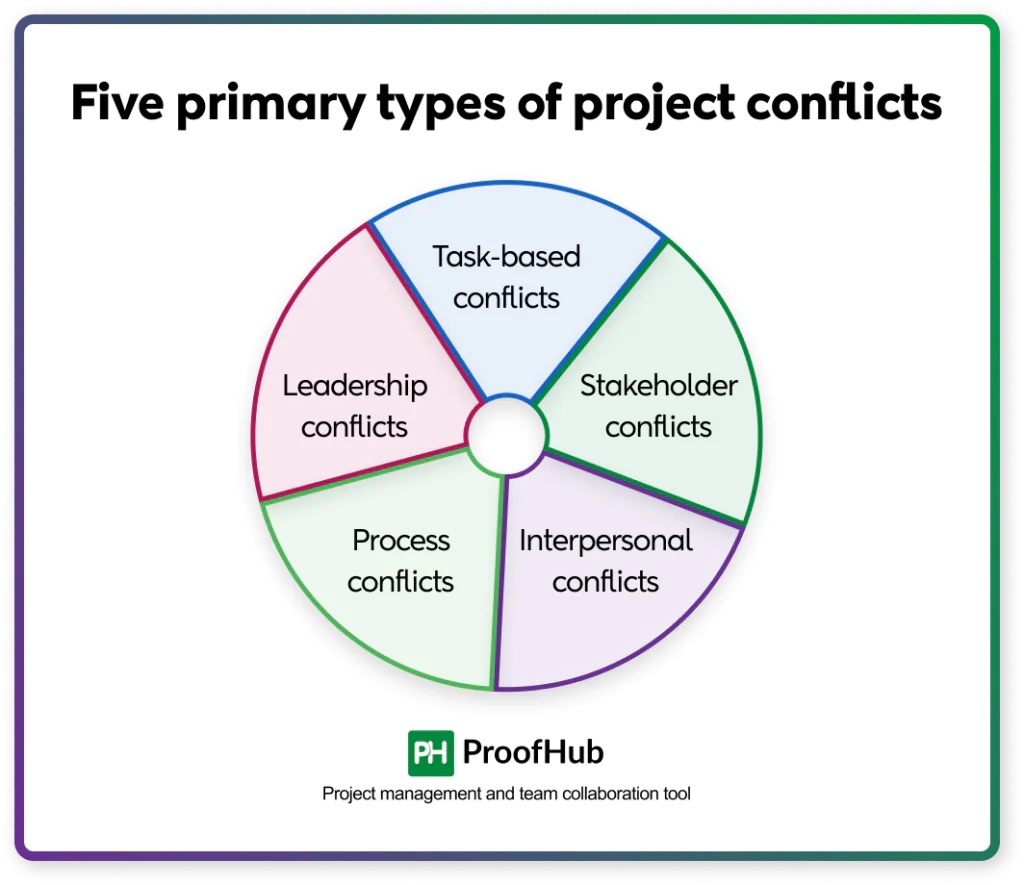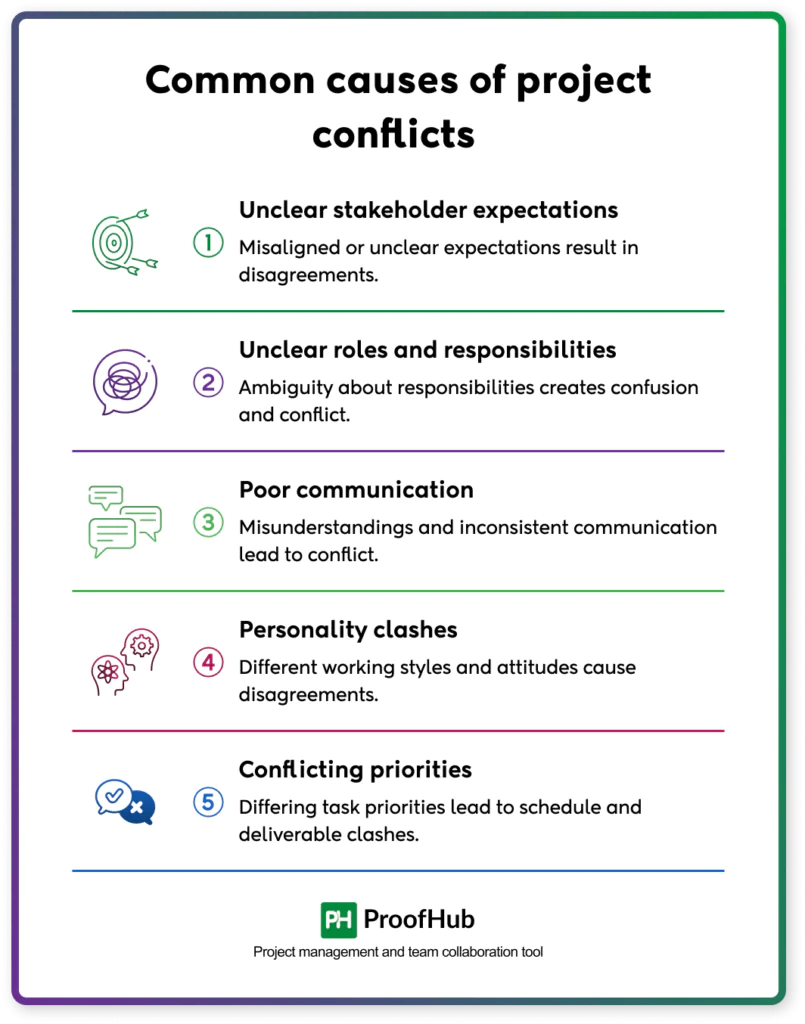Working on a project always comes with some conflicts. It is because when a group of people from diverse backgrounds with varying personalities, working styles, and attitudes work together on a shared goal, it leads to friction and disagreement. Not just the project team, conflicts are also observed at a higher level among project sponsors, key stakeholders, and clients due to varying interests, priorities, and preferences.
And the most intriguing thing about conflict is that everyone involved thinks they are right and their needs are valid. Thus, it is the responsibility of the project manager to use their skills to resolve disagreements and bring everyone on the same page so that the interests of all stakeholders are secured and the project team is aligned and working towards the same goals.
There are certain things you need to do to resolve project conflicts. In this chapter, we will learn about conflict management in a project.
What is conflict management?
Conflict management is a process of identifying, addressing, and resolving conflicts within a project to keep things moving smoothly. Think of it as the skillset that helps project managers turn disagreements into productive conversations rather than roadblocks.
It is the most important aspect of project management because conflicts can derail the project’s progress. Whether it is due to unclear responsibilities, poor team alignment, or stakeholders not being on the same page, unresolved conflicts can create chaos. Left unchecked, they can quickly develop into delays, poor performance, or even project failure.
To understand the impact and why conflicts arise in project management, it is important to first learn about the types of conflicts.

Conflicts in a project are primarily of five types:
- Task-based conflicts: Disagreements about how to complete tasks, deadlines, or the quality of deliverables.
- Stakeholder conflicts: Disputes between project stakeholders, such as conflicting goals of the client and the project team.
- Interpersonal conflicts: Project team conflicts are conflicts originating from personal disagreements or personality differences among team members.
- Process conflicts: Issues regarding project workflows, methodologies, or procedures.
- Leadership conflicts: Conflicts between the project manager and team members, or between team members and project key stakeholders.
Conflicts can derail the project’s progress in the following ways:
- Misaligned goals and priorities: Conflicts lead to unclear or competing priorities among stakeholders or team members. This misalignment diverts the focus away from critical project objectives, leading to inefficiencies or missed goals.
- Poor decision-making: Conflicts create tension and impair communication. This leads to poorly informed decisions or incorrect decisions, resulting in project errors, rework, or even failure to meet objectives.
- Reduced productivity: Conflicts lead to disengagement. It results in a lack of participation and collaboration, resulting in decreased productivity.
- Wasted resources: Conflict means disputes over task ownership, priorities, or methodologies. This leads to a waste of time, money, and effort in resolving conflicts and requires rework. It results in delays in deliverables and impacts the project schedule.
Importance of conflict management
Conflict management plays a key role in determining the success of the project by making sure everyone is on the same page and the interests of all the parties are ensured in the best possible way.
Here are the key benefits of conflict management:
- Improved team collaboration: Preventing conflict in teams reduces misunderstandings and creates a positive team culture. This creates a cooperative environment where team members can work together effectively.
- Improved productivity: Resolving conflicts quickly minimizes disruptions and keeps projects on track. By focusing on team collaboration to reduce conflict, teams spend less time dealing with interpersonal issues and more time focusing on tasks, improving productivity.
- Better decision-making: Conflicts, when managed well, can lead to creative problem-solving and better decision-making. It ensures that all viewpoints are considered, leading to more informed and balanced decisions.
- Alignment with organizational and stakeholder goals: Effective conflict management aligns individual and team efforts with the organization’s overall objectives. A positive team culture promotes collaboration and shared goals, increasing the chances of achieving desired project outcomes.
- Reduces stress: A clear approach to resolving disputes minimizes tension and stress within the team. It fosters trust among team members and creates a supportive and collaborative environment.
Common causes of conflict in projects

There are some common causes of conflicts in projects. Have a look at why conflicts arise in project management.
- Unclear stakeholder expectations: Misaligned or unclear expectations from stakeholders, clients, or sponsors can result in disagreements about the scope or direction of the project.
- Unclear roles and responsibilities: Ambiguity about who is responsible for what can create confusion and conflict among team members.
- Poor communication: Misunderstandings, lack of information sharing, and inconsistent communication lead to miscommunication among team members, which creates conflict.
- Personality clashes: Different working styles, attitudes, or interpersonal issues among team members can cause disagreements and frustration.
- Conflicting priorities: Team members or departments prioritizing their tasks differently can cause friction when schedules or deliverables clash, leading to conflicts.
Now, let’s find out what we can do to prevent and resolve project team conflict.
How to prevent and resolve conflicts in projects?
To prevent and resolve conflicts in a project, most project managers try to use their experience and knowledge. These ad hoc measures sometimes work and sometimes do not. Therefore, it is very important to learn about the structured way to prevent and resolve conflicts.
Certain frameworks and conflict management strategies can help you resolve them. Let’s learn.
1. Prevent conflict
Prevention is better than cure. It holds true for project conflicts too because it helps you save energy, time, and resources invested in conflict management.
Here is how you can prevent conflicts in the team:
- Establish clear communication: Foster open communication channels where team members feel comfortable discussing issues.
- Set clear roles and responsibilities: Define and document individual responsibilities and project deliverables in a Responsibility Assignment Matrix or RACI chart.
- Identify the early signs: Identify the early signs of conflicts to prevent them from growing.
- Regular check-ins: Conduct regular check-ins and meetings to clarify expectations and resolve misunderstandings early.
- Observe and act early as a mediator: Pay close attention to team dynamics and intervene at the first sign of friction to prevent conflict from growing.
If conflicts still occur, you need to resolve them.
2. Recognize conflict
The first step to resolving any conflict is to recognize that there is a conflict. This can be done by carefully observing your team’s behavior or performance. Look for the early signs of conflict in teams.
The most common signs include:
- Poor communication: Team members avoid sharing information or updates
- Poor behavior: Passive-aggressive behavior among team members such as sarcastic remarks or dismissive tones
- Poor collaboration: Some individuals prefer to work in silos rather than collaborating or some team members avoid interacting with specific individuals or groups
- Lack of participation: Decreased participation in meetings, delays in responding to messages, increased absenteeism, and reluctance to take on new responsibilities
- Lack of clarity: Confusion or disagreements about the project’s goals or priorities
Recognizing early signs of conflicts in a team is crucial for addressing issues before they escalate and disrupt project progress.
3. Identify and acknowledge the conflict
Once you recognize the signs of conflict and detect conflict early, it is important to acknowledge the conflict and identify the root cause. Knowing the root cause is half the job done because when you know what to work on, you will eventually end up finding a solution.
Certain things you can do to acknowledge and identify conflicts:
- Schedule a discussion: Create a safe and private environment where everyone feels comfortable sharing their perspectives.
- Ask open-ended questions: Encourage participants to explain their viewpoints without assigning blame.
- Actively listen: Collect information about the conflict by listening to all parties involved. Pay attention to verbal and non-verbal cues. Show empathy and summarize the problem to ensure clarity and that all parties have a shared understanding.
4. Resolve conflicts
The next step is to resolve the conflict. It is the most challenging task because you have to make choices at this step. A project manager may or may not be able to fulfill each individual’s requirements because doing so may not favor the project.
How to resolve project conflict:
1. Act as mediator
Listen to all sides of the conflict objectively and facilitate discussions. Agree on the most practical and mutually beneficial solution to find a win-win resolution.
2. Choose the right approach to resolve conflicts
Thomas Kilman’s Conflict model suggests conflict resolution techniques that help deal with disputes. There are five types of conflict resolution actions you can take. Let’s learn about it.
- Competing: Competing is an assertive and uncooperative approach where you use your power to assert a solution to resolve the conflict quickly. It is often used in urgent or high-stakes situations.
- Accommodating: Accommodating is an unassertive and cooperative approach to conflict where you put others’ needs above your own to resolve conflicts and maintain harmony. It is ideal for non-critical situations.
- Collaborative: Collaborative is an assertive and cooperative approach where you work together to find a mutually beneficial solution that satisfies all parties. It is used for complex conflicts with high stakes.
- Avoiding: Avoiding is an unassertive and uncooperative approach where you try to postpone an issue until a better time. This is because delaying resolution might allow tensions to dissipate. It is ideal when conflicts are minor.
- Compromising: Compromising is a moderately assertive and cooperative approach where you try to find a middle ground. The objective is to find a mutually acceptable solution that satisfies both parties, with each side giving up something to reach a resolution. It is used for moderate stakes and time-sensitive conflicts.
Weigh the chosen solution against project goals and ensure the chosen solution aligns with project objectives and deadlines.
3. Use conflict resolution skills
Use problem-solving, active listening, and negotiation to resolve conflict. Here is a brief explanation:
- Active listening: Encourage all parties to share their perspectives without interruption, fostering mutual understanding.
- Negotiation: Help team members reach a compromise that satisfies all parties while aligning with project goals.
- Problem-solving approach: Focus on identifying the root cause of the conflict and collaboratively developing actionable solutions.
5. Implement the solution, monitor progress, and document lessons learned
Put the chosen solution into action with a clear plan and follow up to ensure it is working as intended. It can include the following:
- Assign responsibilities: Define who is responsible for each action item.
- Set deadlines: Establish timelines to ensure accountability and progress.
- Communicate changes: Inform the team or stakeholders if the resolution affects existing project workflows.
- Check-in regularly: Schedule follow-up meetings or touchpoints to review progress. Monitoring helps ensure that the resolution is effective and sustainable.
- Solicit feedback: Ask involved parties if the solution has resolved the conflict and if any adjustments are needed.
A well-executed plan ensures that the conflict is resolved effectively.
Analyze the conflict and its resolution to identify lessons for the future. Discuss what worked well and what could be improved in the conflict resolution process with the team. Revise project management practices or team norms to prevent similar conflicts.
This is a complete approach to conflict resolution.
Additional tips: You can follow these additional practices to master conflict resolution:
- Stay neutral and professional: Avoid taking sides and focus on facts rather than emotions.
- Maintain respect: Encourage respectful dialogue and discourage personal attacks or blame.
- Be solution-oriented: Keep the focus on finding a resolution rather than dwelling on the problem.
Turn conflicts into an opportunity for growth
Conflict is essentially a disagreement between the interests of two individuals. This disagreement can be turned into an opportunity for growth and collaboration or conflict and resentment. It is in the hands of a project manager to navigate the disagreements, turn them into success, and ensure the interests of all project stakeholders are secured and assured.






